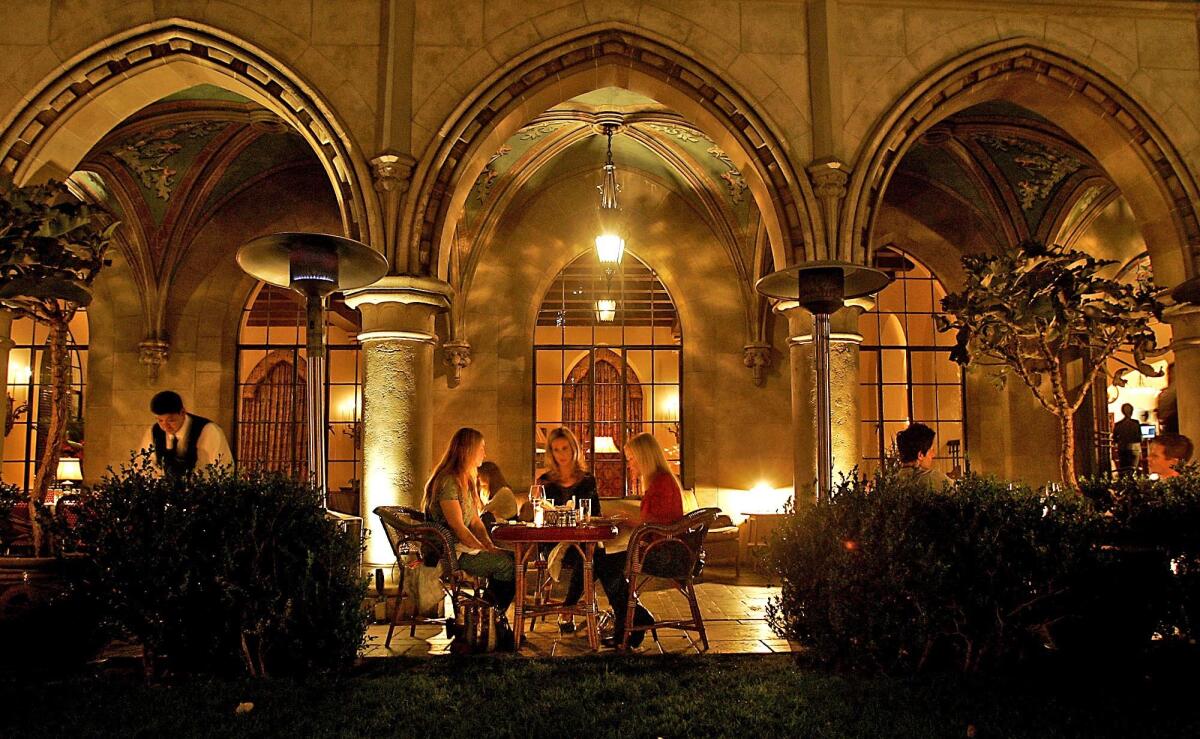Op-Ed: Chateau Marmont may become members-only — perhaps saving it financially but costing its soul

- Share via
In February 1929, Los Angeles lawyer Fred Horowitz opened the apartment building he had built just west of the city limits on an unpaved stretch of Sunset Boulevard. Named Chateau Marmont, it looked like a Loire Valley castle in France and was marketed to burghers of outlying cities seeking pieds-à-terre in a spot Horowitz believed would one day be the center of the growing metropolis.
Eight months later, the stock market crashed, and with it Horowitz’s dream. In 1932, he sold the building to Hollywood film pioneer Albert Smith, who changed it into a residential hotel, with parking spaces and kitchens and a level of seclusion akin to a private residence, ideal for folks in town for a spell to make movies. Since then, Chateau Marmont has endured, gorgeously, as Hollywood’s version of New York’s funky Chelsea Hotel, a nook of film world naughtiness, as infamous as a speakeasy, an icon of the Sunset Strip, an emblem of the high life of Lotusland.
Now, with the pandemic choking the travel business, the Chateau may become a members-only institution, although, given its hush-hush reputation, you could be forgiven for thinking, “Isn’t it already?”
The Chateau has long been a VIP club that only pretends to be open to the public — with its self-enclosed suites and bungalows, mere 63 rental units, rooms priced for the wealthy or expense-accounted, a guest registry consisting largely of repeat visitors and paparazzi ever-prowling its entrance.
And according to André Balazs, who bought the place in 1990 and has owned it longer than anyone else, the pretending may soon cease. Earlier this week, Balazs revealed that he plans to sell, in effect, time-shares in the legendary hotel, limiting access to its rooms to select member-investors. He explained it as a way to contain COVID spread — residents would constitute a closed, trusted loop.
Although he didn’t mention it, an infusion of initiation fees and membership dues would be a godsend, as the Chateau, like most hotels, has withered during the pandemic. In March, it shut its doors to all but a handful of guests and Balazs dismissed almost the entire staff, inciting legal backlash and dreadful publicity.
Transforming the Chateau into a members-only operation may be smart business, but it has only fueled the negative chatter. The immediate response, from longtime Chateau denizens and fired staffers alike, has been outrage. People speak as if something has been taken from them. The sad truth, though, is that the hotel has been out of reach of the general public for years.
Under Balazs, the Chateau morphed from a bohemian bolthole for creative oddballs into a luxury boutique destination and fashionable brand; bungalows and suites that went for $250 a night 30 years ago recently rented for upward of $3,000. An heir to a biomedical fortune who had never owned a hotel before, Balazs paid a reported $12 million for the property, long bemoaned as much as beloved for the indifferent state of its facilities. He added a gym, a bar and a restaurant, and gave the place a veneer of opulence that it had never enjoyed, even at its most plush, which was never very. He turned it from grungy to glamorous with an almost invisible touch.
Still, if the hotel has always been private in the sense of “exclusive,” it is also a public asset, a registered historic cultural landmark. Even those who’ve never set foot in it can lay claim to Chateau Marmont — as an anchor of West Hollywood, a sidebar to the movie business, a symbol of chic, sinful La La Land. Like the Paramount Studios gate or the neon sign of Musso & Frank Grill, it conjures a place, a business, a mood.
Chateau Marmont is a folly and a survivor. It has weathered the Great Depression, World War II blackouts, the 1966 Sunset Strip riots (which began across the street), spells of indifferent management, and the hurricane tenancy and tabloid-churning death of John Belushi on its premises in 1982. Some of its short-term owners in the ’60s and ’70s considered it a tear-down.
Developer Raymond Sarlot was looking for a tax write-off when he and an associate paid $1 million for a down-on-its-luck Hollywood landmark, the Chateau Marmont, in 1975.
That it was once something of a dive only adds to its tremendous coolness today. Even done up, Chateau Marmont, at 92 years old, hasn’t lost its air of naughtiness. It has uncontested cred as a creative garden for writers, musicians and painters, and as a haven for people who, in less tolerant times, might have been turned away elsewhere: gay men and women, people of color (a previous owner, anti-fascist German banker Erwin Brettauer, welcomed Black guests in the ’50s, breaking a taboo that other Westside hotels maintained). Chateau management has traditionally looked the other way at late-night partiers and legions of hookers-up, and they’ve always had space for freshly separated famous spouses — Desi Arnaz, who quarreled endlessly with Lucille Ball, practically kept a room on retainer.
But under Balazs, many of the hotel’s traditional clients have gradually been priced out, and the idea that they might be turned away altogether for want of a membership feels contrary to the Chateau’s iconoclastic spirit.
For decades, staying at Chateau Marmont seemed to encourage guests to get up to all manner of mischief, but it also inspired their work on novels and films and music, as well as occasional outré behavior that can accompany creative endeavors. It’s hard to imagine that folks who can afford steep fees for proprietary access to the hotel will be overly tolerant of those sorts of antics. Balazs’ inspiration to sell memberships might keep the Chateau going financially, but it could do so at the expense of its soul, a case of pawning the crown jewels to save the castle.
Shawn Levy is the author of “The Castle on Sunset: Life, Death, Love, Art, and Scandal at Hollywood’s Chateau Marmont.”
More to Read
A cure for the common opinion
Get thought-provoking perspectives with our weekly newsletter.
You may occasionally receive promotional content from the Los Angeles Times.










